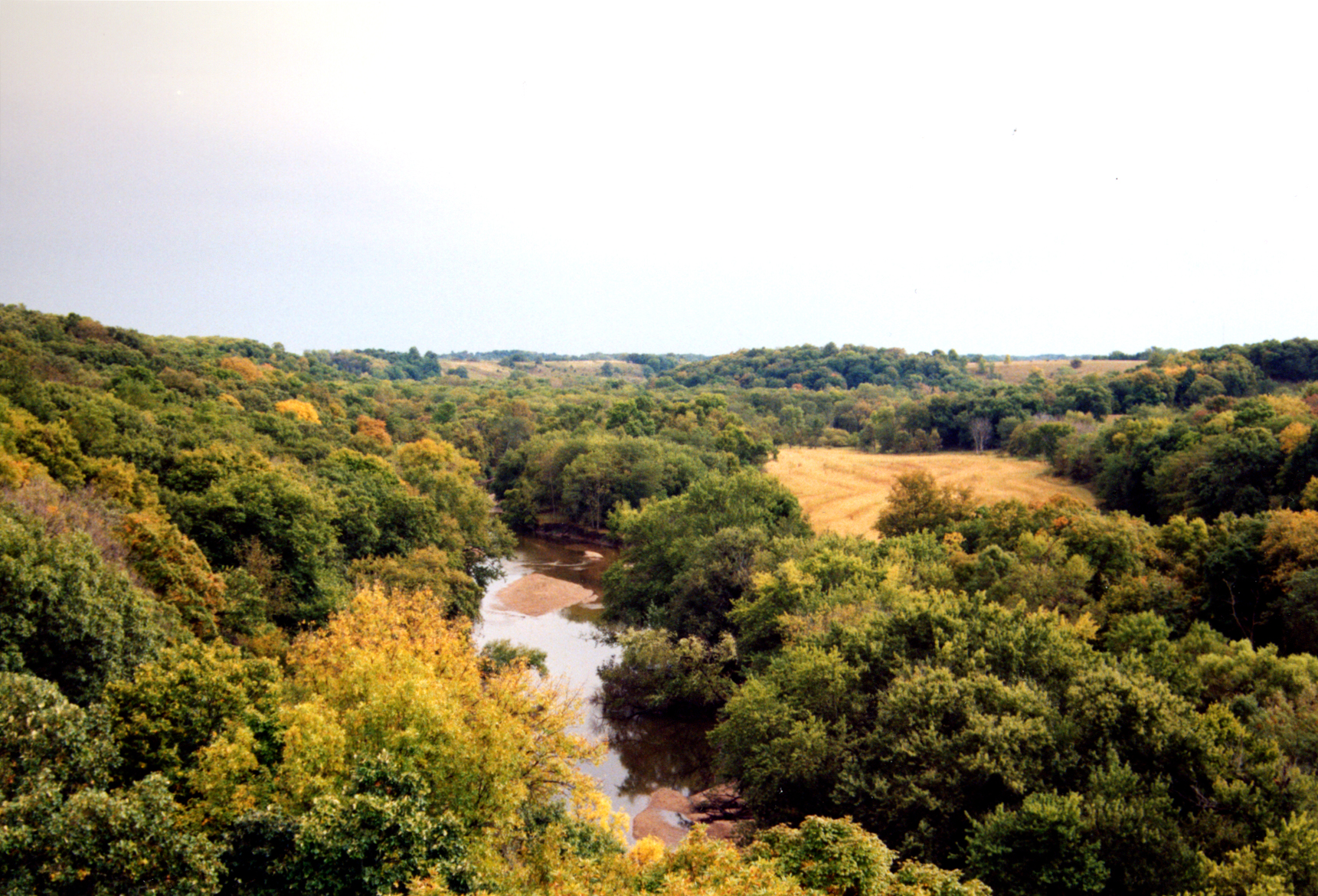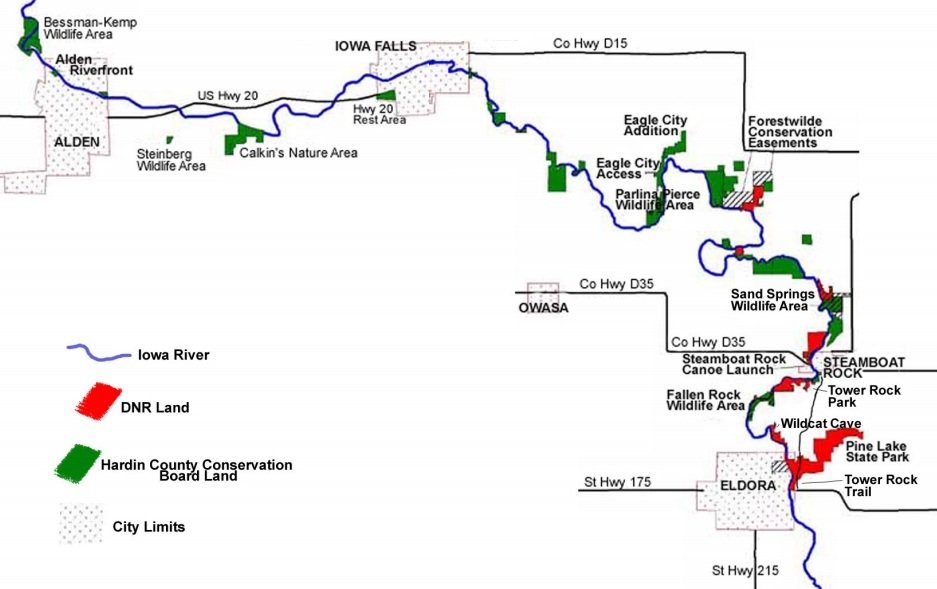Explore Iowa: Iowa River Greenbelt
Posted on June 9, 2016 in Blog
 The Iowa River Greenbelt through Hardin County is a picturesque landscape of valleys, woods and streams tucked in the midst of flat, fertile farmland. This area offers an unusual concentration of recreational opportunities, diverse wildlife habitats and spectacular views.
The Iowa River Greenbelt through Hardin County is a picturesque landscape of valleys, woods and streams tucked in the midst of flat, fertile farmland. This area offers an unusual concentration of recreational opportunities, diverse wildlife habitats and spectacular views.
This 42-mile stretch of river valley goes from Alden through Iowa Falls, Steamboat Rock, Eldora and Union.
Three geological landforms converge in this region: the Wisconsin Surface, the Iowa Drift Plain and the Southern Iowa Drift Plain. The Iowa River in Hardin County is influenced by all three landform regions.
The character of the river ranges from a low, rock-lined channel near Alden to a narrow gorge and bluffs at Iowa Falls. Between Iowa Falls and Steamboat Rock, the bluffs recede from the river and the valley widens, deepens and is distinguished by terraces along the sides of the valley. From about Steamboat Rock to Eldora, the river flows along the edge of the Bemis End Moraine, where the receding glacier dumped much of its rocky load. Here the valley is gorge-like, dramatically deep and narrow.
The Iowa River Greenbelt is home to a variety of plants and animals in aquatic, grassland, savanna/shrub, riparian and woodland habitats. Some sections contain rare and endangered plant and animal species, including the northern monkshood plant, bald eagles and three species of freshwater mussels. The area is also home to the only sharp-shinned hawk nest found in Iowa for many decades. The black-billed cuckoo, wood thrush, bobolink, and even cerulean warbler and pileated woodpecker are found within the various habitats. Meanwhile, chorus frogs and cricket frogs are often heard in the area wetlands.
Some parts of the Greenbelt, especially the deepest sections, contain small pockets of plants and trees like those located in the "driftless" area of northeast Iowa, including white pine, paper birch, yellow birch and other plants. The trees located in the Greenbelt provide brilliant displays of color when the leaves change in the fall.
Read on to learn more about this stunning natural area, what you can see/do there and how Iowa Natural Heritage Foundation is protecting the greenbelt with the help of many partners.
Iowa River Greenbelt: Plan Your Visit
The Greenbelt offers a multitude of recreational opportunities including canoeing, hiking, biking, boating, tubing, camping, fishing, birdwatching, swimming, hunting and golfing.
Most of the Greenbelt is accessible by taking the Iowa River Greenbelt Scenic Drive, which extends from Alden to Eldora. The area is also accessible by foot, bike or boat.
Highlighted public areas
Use this map to find the public areas identified below. The numbers below correspond with numbers on the map. Get more detailed maps and information from the Hardin County Conservation Board.

- Bessman-Kemp Wildlife Area
- Calkins Nature Area. This nature area, also the headquarters for Hardin CCB, contains 76 acres of woodland, wetland and reconstructed native prairie. There are two miles of trails near the nature center, as well as an arboretum near the prairie. The nature center includes a wildlife exhibit with more than 80 species of animals from pheasants and deer to raptors, reptiles and amphibians. The nature center specializes in raptor rehabilitation.
- Eagle City Park
- Sand Springs Wildlife Area: This 221-acre park along the Iowa River is 1.5 miles north of Steamboat Rock. The area has heavily timbered ridges, a small wetland and many wildflowers. Along a ridge above the river lie 27 sacred Indian mounds. INHF assisted Hardin County in acquiring this land.
- Tower Rock County Park offers camping, picnicking, hiking, fishing and hunting. Exposed sandstone and limestone cliffs provide a spectacular view when passing on the river.
- At Fallen Rock Preserve, located just west of Tower Rock, the Iowa River has carved deep bluffs through sandstone bedrock. The area has white pine, yellow birch and white birch, and a large number of raptors travel through the area during fall and spring migrations.
- Wildcat Cave Area, a quarter mile north of Eldora along the Iowa River, is home to a variety of trees, an isolated prairie and a seasonal waterfall. INHF acquired two properties to help complete the Wildcat Cave project, which is now managed by Hardin County Conservation Board.
- Pine Lake State Park is a heavily wooded 585-acre state park located near Eldora. The park features rolling bluffs with 250-year-old white pine trees, two lakes (a 50-acre lower lake and 69-acre upper lake), more than 10 miles of well-established trails, campgrounds, four restored Civilian Conservation Corps cabins and a concession stand. INHF recently helped the DNR acquire a 68-acre addition to Pine Lake State Park.
- The Pine Lake and Tower Rock Trails are actually two different trails that run seamlessly together.Together, they form a 4.5-mile paved multiuse recreation trail that connects two parks and two towns. The portion of the trail within Pine Lake State Park is called the Pine Lake Trail (3 miles), while the portion from north of the park boundaries to Steamboat Rock is the Tower Rock Trail (1.5 miles).
The recreation areas and activities mentioned above are only a few of the many that can be found along the Iowa River Greenbelt. More information on these areas and those not mentioned are available through the Greenbelt communities, Hardin County Conservation Board and other resources.
Links for Visitors
http://www.hardincountyconservation.com/
An overview of the Greenbelt, a chart of the parks and facilities in Hardin County, a calendar of events, notes from the HCCB naturalist
http://www.iowadnr.gov/Recreation/CanoeingKayaking/WaterTrails.aspx
Information on the composition and characteristics of the Iowa River, dam locations, where to find canoe accesses and the distances between them
www.rock-n-row-adventures.com
This is the only outfitter that provides tube rides on eight miles of scenic river right in the heart of the Iowa River Greenbelt
www.stateparks.com/pine_lake.html
Get a general overview of Pine Lake State Park and find links to information on local events
www.co.hardin.ia.us/
Links to the Web sites of the towns in Hardin County, a calendar of events, historical information
www.cr.nps.gov/nr/travel/hardin/preserve.htm
A brief history of the Iowa River and Hardin County, information on and maps of Pine Lake State Park, Calkin's Nature Center, Prairie Bridges Park and other historic places
www.iowadnr.gov/parks/state_park_list/index.html
Find information on state parks and recreation areas: maps, lists of parks, park rules and regulations, cabin rental information, trails, a calendar of events, camping tips and recipes
www.traveliowa.com
This is the official Web site of Iowa Tourism. Search attractions, accommodations and events across the state based on travel areas in Iowa or a particular town. The site is also a great source for general state information
Iowa River Greenbelt: Protection
In 1919, famed Iowa State University botanist L.H. Pammel first recommended that the region where the Iowa River runs through Hardin County be protected. Then, in the 1950s, the Hardin County Conservation Board named the area the Iowa River Greenbelt and began protecting it.
In 1987, the Iowa River Greenbelt Resource Trust (IRGRT) was formed under the umbrella of INHF. This group involved the county, communities and citizens in developing a master plan that outlined conservation needs along with environmental education, recreation and tourism opportunities for the area. The plan, developed by Crose Gardner & Associates, proposed four segments to balance conservation and habitat protection with recreation and tourism development along the Greenbelt.
For 20 years, INHF has worked to protect the Iowa River Greenbelt's precious areas. In that time, INHF has played a role in completing more than ten projects in the Greenbelt, from providing funding for projects to acting as interim landowner to serving as easement monitor.
This work has come on both public and private lands. One example of INHF's work in protecting private land is a conservation easement donated to INHF by Bob and Joell de Neui. This easement helped create a 700-acre complex of protected land in what is considered the "heart of the Greenbelt." Read an Iowa Natural Heritage magazine article about the de Neui easement here.
INHF has also been involved in many public land projects along the Greenbelt such as Sand Springs Wildlife Area, Sandstone Palisades (now Fallen Rock Wildlife Area), a Wildcat Cave addition, and an addition to Pine Lake State Park.